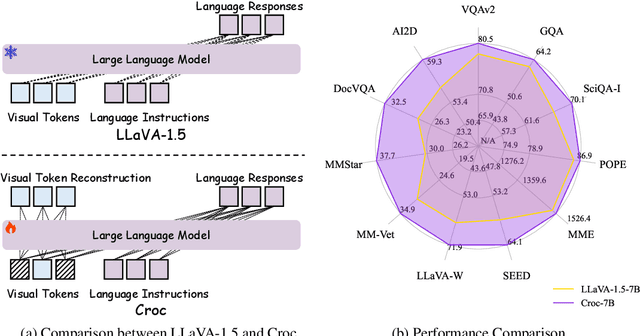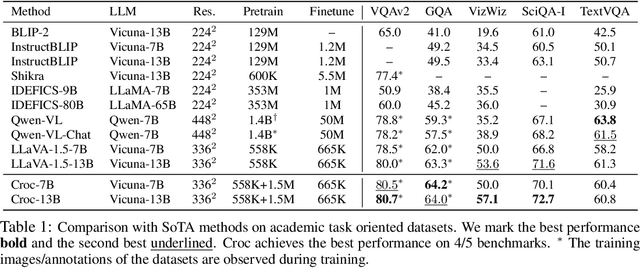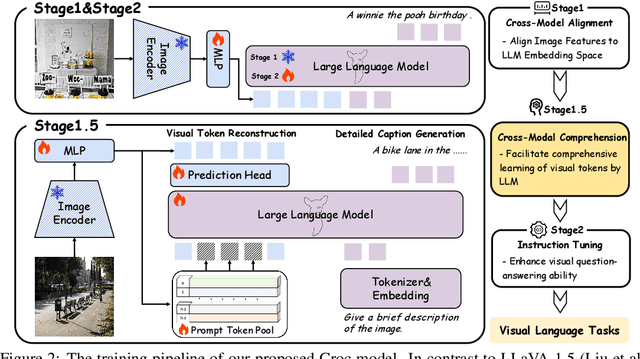Yin Xie
RealSyn: An Effective and Scalable Multimodal Interleaved Document Transformation Paradigm
Feb 18, 2025Abstract:After pre-training on extensive image-text pairs, Contrastive Language-Image Pre-training (CLIP) demonstrates promising performance on a wide variety of benchmarks. However, a substantial volume of non-paired data, such as multimodal interleaved documents, remains underutilized for vision-language representation learning. To fully leverage these unpaired documents, we initially establish a Real-World Data Extraction pipeline to extract high-quality images and texts. Then we design a hierarchical retrieval method to efficiently associate each image with multiple semantically relevant realistic texts. To further enhance fine-grained visual information, we propose an image semantic augmented generation module for synthetic text production. Furthermore, we employ a semantic balance sampling strategy to improve dataset diversity, enabling better learning of long-tail concepts. Based on these innovations, we construct RealSyn, a dataset combining realistic and synthetic texts, available in three scales: 15M, 30M, and 100M. Extensive experiments demonstrate that RealSyn effectively advances vision-language representation learning and exhibits strong scalability. Models pre-trained on RealSyn achieve state-of-the-art performance on multiple downstream tasks. To facilitate future research, the RealSyn dataset and pre-trained model weights are released at https://github.com/deepglint/RealSyn.
Croc: Pretraining Large Multimodal Models with Cross-Modal Comprehension
Oct 18, 2024



Abstract:Recent advances in Large Language Models (LLMs) have catalyzed the development of Large Multimodal Models (LMMs). However, existing research primarily focuses on tuning language and image instructions, ignoring the critical pretraining phase where models learn to process textual and visual modalities jointly. In this paper, we propose a new pretraining paradigm for LMMs to enhance the visual comprehension capabilities of LLMs by introducing a novel cross-modal comprehension stage. Specifically, we design a dynamically learnable prompt token pool and employ the Hungarian algorithm to replace part of the original visual tokens with the most relevant prompt tokens. Then, we conceptualize visual tokens as analogous to a "foreign language" for the LLMs and propose a mixed attention mechanism with bidirectional visual attention and unidirectional textual attention to comprehensively enhance the understanding of visual tokens. Meanwhile, we integrate a detailed caption generation task, leveraging rich descriptions to further facilitate LLMs in understanding visual semantic information. After pretraining on 1.5 million publicly accessible data, we present a new foundation model called Croc. Experimental results demonstrate that Croc achieves new state-of-the-art performance on massive vision-language benchmarks. To support reproducibility and facilitate further research, we release the training code and pre-trained model weights at https://github.com/deepglint/Croc.
Plug-and-Play Grounding of Reasoning in Multimodal Large Language Models
Mar 28, 2024Abstract:The surge of Multimodal Large Language Models (MLLMs), given their prominent emergent capabilities in instruction following and reasoning, has greatly advanced the field of visual reasoning. However, constrained by their non-lossless image tokenization, most MLLMs fall short of comprehensively capturing details of text and objects, especially in high-resolution images. To address this, we propose P2G, a novel framework for plug-and-play grounding of reasoning in MLLMs. Specifically, P2G exploits the tool-usage potential of MLLMs to employ expert agents to achieve on-the-fly grounding to critical visual and textual objects of image, thus achieving deliberate reasoning via multimodal prompting. We further create P2GB, a benchmark aimed at assessing MLLMs' ability to understand inter-object relationships and text in challenging high-resolution images. Comprehensive experiments on visual reasoning tasks demonstrate the superiority of P2G. Noteworthy, P2G achieved comparable performance with GPT-4V on P2GB, with a 7B backbone. Our work highlights the potential of plug-and-play grounding of reasoning and opens up a promising alternative beyond model scaling.
 Add to Chrome
Add to Chrome Add to Firefox
Add to Firefox Add to Edge
Add to Edge